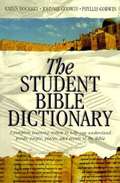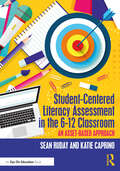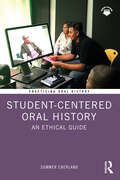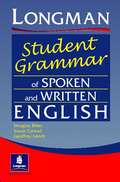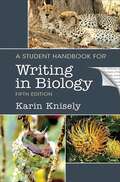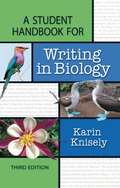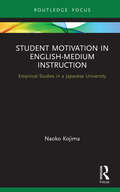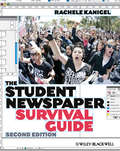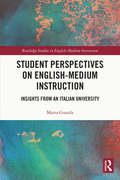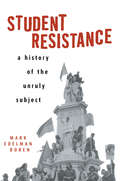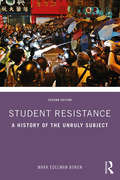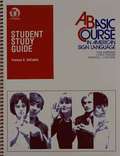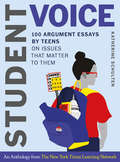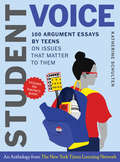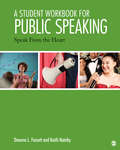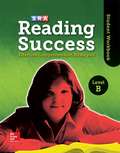- Table View
- List View
The Student Bible Dictionary: A Complete Learning System to Help You Understand Words, People, Places, and Events of the Bible
by Karen Dockrey Johnnie Godwin Phyllis GodwinHere's a concise, easy-to-use reference book for students of all ages who seek to learn more about the Bible and its times. The Student Bible Dictionary features definitions and explanations of hundreds of Bible words, names, places, and concepts. Special color coding, meanwhile, adds special emphasis to important topics which feature additional information geared toward the student reader. From AARON to ZIPPORAH, the Student Bible Dictionary is a whole library of accessible, useful information!
Student-Centered Literacy Assessment in the 6-12 Classroom: An Asset-Based Approach
by Sean Ruday Katie CaprinoIn this practical and accessible book, you’ll learn how to create equitable and meaningful assessments in your instruction through an inquiry-based approach. Ruday and Caprino reimagine what asset-based literacy assessments can be and what they look like in practice by understanding that effective, asset-based literacy assessments must center on students: they must incorporate students’ unique perspectives, ideas, and experiences in meaningful and relevant ways. Instead of using assessments that focus on identifying what students don’t know, the practices presented in this book provide authentic opportunities for students to use what they do know to demonstrate their knowledge of important literacy concepts. The book is organized into three easy-to-use parts that cover: Key concepts of asset-based assessment Specific ways that these practices can be put into action Putting it all together in your own education context. A great resource for busy teachers, this book features a guide for teachers to use during professional development book studies and ready-to-implement templates when applying the assessment practices described in the book.
Student-Centered Oral History: An Ethical Guide (Practicing Oral History)
by Summer CherlandStudent-Centered Oral History explores the overlaps of culturally relevant teaching, student-centered teaching, and oral history to demonstrate how this method empowers students, especially those from historically underrepresented communities. With tangible tools like lesson plans and reflection sheets, available to download as eResources from the book's website, each interactive chapter is applicable to classrooms and age groups across the globe. Educators from all levels of experience will benefit from step-by-step guides and lesson plans, all organized around guiding questions. These lessons coach students and educators from start to finish through a student-centered oral history. Background research, historical context, cultivating a culture of consent, analysis, promotion, and gratitude are among the many lessons taught beyond writing questions and interviewing. With a specific focus on the ethics influencing a teacher’s role as guide and grader of a student-centered oral history, this book also highlights successful approaches across the world of students and teachers discovering oral history. These examples reveal how student-centered oral history empowers academic achievement, radicalizes knowledge, develops relationships, and promotes community engagement. This book is a useful tool for any students and scholars interested in oral history in an educational setting.
Student Companion All-in-One Workbook 7th Grade
by Prentice HallPearson Literature Common Core 7th Grade Workbook
Student Grammar of Spoken and Written English
by Douglas Biber Susan Conrad Geoffrey LeechExamines patterns of use in the news, fiction and academic English Takes grammar and vocabulary together and looks at how they interact Is based on the analysis of 40-million words of British and American, written and spoken corpus text Uses over 3000 examples of real, corpus English to illustrate the points Uses frequency tables and graphs to make the new findings of this grammar clear
A Student Handbook for Writing in Biology
by Karin KniselyA Student Handbook for Writing in Biology, Fifth Edition, provides practical advice to students who are learning to write according to the conventions in biology. The first chapter introduces the scientific method and experimental design. Because the scientific method relies on the work of other scientists, Chapter 2 provides instructions for finding primary literature using article databases and scholarly search engines. Journal articles have a well-defined structure, but are typically hard to read because they are written for specialists. To help students read and comprehend the technical literature, Chapter 3 describes scientific paper tone and format, provides strategies for reading technical material, emphasizes the importance of paraphrasing when taking notes, and gives examples of how to present and cite information to avoid plagiarism. Using the standards of journal publication as a model, students are then given specific instructions for writing their own laboratory reports with accepted format and content, self-evaluating drafts, and using peer and instructor feedback to refine their writing. Besides writing about it, scientists communicate scientific knowledge through posters and oral presentations. How these presentation forms differ from papers in terms of purpose, content, and delivery is the subject of the last two chapters of the book. <p><p>Scientific communication requires more than excellent writing skills--it requires technical competence on the computer. Most first-year students have had little experience producing Greek letters and mathematical symbols, sub- and superscripted characters, graphs, tables, and equations. Yet these are characteristics of scientific papers that require a familiarity with the computer beyond basic keyboarding skills. Furthermore, most first-year students are used to doing calculations on a handheld calculator. When they learn how to use Excel's formulas to do repetitive calculations, their time spent on data analysis decreases markedly. For exactly these reasons, almost half of the book is devoted to Microsoft Word, Excel, and PowerPoint features that enable scientists to produce professional quality papers, graphs, posters, and oral presentations effectively and efficiently.
A Student Handbook for Writing in Biology
by Karin KniselyThis book provides practical advice to students who are learning to write according to the conventions in biology, including step-by-step guidance and numerous examples of faulty writing (along with revisions) to alert students to pitfalls when writing different sections of a scientific paper. Most of the sections are designed to stand alone so that readers can look up a topic in the index and find the answer to their question. Those who want to learn more about the topic have the option of reading related sections or entire chapters. Most first-year students have had little experience producing Greek letters and mathematical symbols, sub- and superscripted characters, graphs, tables, drawings, and equations. For exactly this reason, almost half of the book is devoted to Microsoft Word, Excel, and PowerPoint features that enable scientists to produce professional quality papers, graphs, posters, and oral presentations effectively and efficiently.
Student Motivation in English-Medium Instruction: Empirical Studies in a Japanese University (Routledge Focus on English-Medium Instruction in Higher Education)
by Naoko KojimaThis book explores Japanese students’ learning experiences and challenges in English medium instruction (EMI) from motivational perspectives. Using self-determination theory (SDT) as the framework, the first part reveals a lack of the three psychological needs of SDT (autonomy, competence, relatedness) that cause loss of students’ initial interest in learning English language and content. The author outlines pedagogical interventions that can be implemented in order to make the learning environment better. The second half of the book shows the effects these interventions had on the fulfillment of the three psychological needs, especially perceived relatedness and autonomy. In conclusion, the author focuses on the importance of listening to Japanese students’ voices and building a community that can motivate students, thus maximizing the pedagogical effectiveness of EMI. This volume will be useful to anyone involved in motivation, language learning or EMI research, pedagogy or practice.
Student Mybook Softcover Volume 1 Grade 5 (Into Reading)
by Houghton Mifflin HarcourtInto ReadingTM my Book
The Student Newspaper Survival Guide
by Rachele KanigelThe Student Newspaper Survival Guide has been extensively updated to cover recent developments in online publishing, social media, mobile journalism, and multimedia storytelling; at the same time, it continues to serve as an essential reference on all aspects of producing a student publication. Updated and expanded to discuss many of the changes in the field of journalism and in college newspapers, with two new chapters to enhance the focus on online journalism and technology Emphasis on Web-first publishing and covering breaking news as it happens, including a new section on mobile journalism Guides student journalists through the intricate, multi-step process of producing a student newspaper including the challenges of reporting, writing, editing, designing, and publishing campus newspapers and websites Chapters include discussion questions, exercises, sample projects, checklists, tips from professionals, sample forms, story ideas, and scenarios for discussion Fresh, new, full color examples from award winning college newspapers around North America Essential reading for student reporters, editors, page designers, photographers, webmasters, and advertising sales representatives
Student Perspectives on English-Medium Instruction: Insights from an Italian University (Routledge Studies in English-Medium Instruction)
by Marta GuardaThis book offers a window into student perceptions of English-Medium Instruction (EMI), building on research from an Italian university to provide a better understanding of attitudes toward EMI in Europe and future directions for cross-country comparative research.The volume provides context on the current situation with EMI in Italy, unpacking debates around the tensions between the increased competitiveness it brings at the higher education level with the potential detrimental impact of English on local language practices. Seeking to introduce a counterpoint to existing research on lecturer experiences, Guarda draws on a wide range of data, from online questionnaires to semi-structured interviews and a focus group, toshowcase perceptions on EMI from students enrolled in English-Taught Programmes at the University of Padova over a two-year period. The resulting insights contribute to the current literature on EMI toward creating a clearer and more holistic picture of the advantages and challenges of learning through English and implications for quality improvement measures for EMI implementation in Italy, Europe and beyond.This book will be of interest to scholars in English-Medium Instruction and applied linguistics, especially to those working on issues around language policy, bilingual education and the internationalisation of higher education.
Student Reader Two (Wilson Reading System®)
by Wilson Language Training CorporationThe word lists, sentences, and passages address core and academic vocabulary. Word lists include Level AB, Level A, and Level B vocabulary. Sentences and passages include targeted high frequency words as well as Level AB and Level B vocabulary.
Student Resistance: A History of the Unruly Subject
by Mark Edelman BorenStudent Resistance is an international history of student activism. Chronicling 500 years of strife between activists and the academy, Mark Edelman Boren unearths the defiant roots of the ivory tower.
Student Resistance: A History of the Unruly Subject
by Mark Edelman BorenStudent Resistance: A History of the Unruly Subject observes the rise and progression of student activism across the globe. By selecting critical case studies from the medieval to modern period, Mark Boren reveals how friction between activists and the academy can culminate in a violent struggle for power. Using a uniquely international approach, the book offers a comprehensive introduction to the history of university activism and its influence on national politics and broader social movements. Specific instances of resistance, from medieval uprisings across European universities to the Tiananmen Square Massacre, are explored to produce a detailed historical study of power relations and oppression. Globalization and rapid technological advances have established more accessible platforms for collective activism whilst recent political upsets have generated a ripe environment for students to increase their efforts of resistance. This second edition addresses repercussions of the internet and social media age on the evolution of campus activism in the United States and abroad, from #blacklivesmatter to the Palestinian West Bank protests. This timely revision of Student Resistance continues to reflect on the vital role that resistance plays in the evolution of modern societies and the book remains an essential text for both students and scholars of youth activism.
Student Study Guide for use with Traditions and Encounters, A Global Perspective on the Past, Volume 1, From the Beginning to 1500
by Rose Mary Sheldon Herbert F. Ziegler Jerry H. BentleyNIMAC-sourced textbook
Student Study Guide to a Basic Course in American Sign Language
by Tom Humphries Carol Padden Terrence J. O'Rourke Frank A. PaulStudent Study Guide to a Basic Course in American Sign Language
Student Test Prep Booklet: Lesson 200-204 (Fountas & Pinnell LLI Purple #Level W)
by Fountas PinnellLeveled Literacy Intervention PURPLE System Student Test Preparation Booklet: LEVEL W LESSONS 201-204
Student Test Preparation Booklet Level L: Lessons 29-32 (Fountas & Pinnell LLI Red #Level L)
by HeinemannStudent Test Preparation Booklet LEVEL L LESSONS 29-32
Student Test Preparation Booklet Level Q: Lessons 189-192 (Fountas & Pinnell LLI Red #Level Q)
by HeinemannStudent Test Preparation Booklet LEVEL Q LESSONS 189-192
Student Voice: 100 Argument Essays By Teens On Issues That Matter To Them
by Katherine SchultenFinally, mentor texts written by teenagers, to help your students craft convincing arguments. In this new collection of 100 essays curated by The New York Times, students will find mentor texts written by their peers—13-to-18-year-olds—on a wide range of topics, including social media, race, video games, lockdown drills, immigration, tackle football, and the #MeToo movement. All of the essays were either winners or runners-up from The New York Times Learning Network 2014–2019 Student Editorial contests, in which students could take on any issue they liked and, in 450 words or fewer, persuade readers—including educators from around the country as well as Times judges—to adopt their point of view. The essays have been selected for their voice, style, and use of evidence, as well as to present snapshot of issues across a dozen categories that are of particular interest to adolescents. Student Voice is also available as a package with Raising Student Voice: 35 Ways to Help Students Write Better Argument Essays, from The New York Times Learning Network, a teacher's companion guide packed with practical advice from teachers, Times editors, and even student winners about how to use these essays in writing instruction.
Student Voice Teacher's Special: From The New York Times Learning Network
by Katherine SchultenHelp your students craft convincing arguments with award-winning mentor texts written by teenagers and companion teaching guide. This bundle includes one copy each of Student Voice: 100 Argument Essays by Teens on Issues That Matter to Them and Raising Student Voice: 35 Ways to Help Students Write Better Argument Essays, from The New York Times Learning Network. At a time when examples of “student voice” are everywhere, from Greta Thunberg to the Parkland students to the teenagers in the streets of Hong Kong, the argument writing that students study in school is still almost entirely written by adults. It is a wholly different experience for teenagers to study the work of their peers. It’s relatable. It’s relevant. And it doesn’t feel like an untouchable ideal. In this new collection of 100 essays curated by The New York Times, students will find mentor texts written by their peers—13-18-year olds—on a wide range of topics including social media, race, school lockdown drills, immigration, tackle football, the #MeToo movement, and COVID-19. For any teacher who feels that students write better when they have some choice over the topic and form, when they write for an audience beyond the teacher and a purpose beyond a grade, and when they get to sound like themselves, this anthology is an invaluable resource to accompany any composition text. In the companion teacher’s guide, Katherine Schulten—a former teacher and writing coach herself—provides teachers with 35 strategies and classroom-ready activities for using these peer mentor texts with their students. Raising Student Voice also includes 500 writing prompts, a “topic generator” with questions to help students decide what they’d like to write about, and a sample essay annotated with the comments of Times judges.
A Student Workbook for Public Speaking: Speak From the Heart
by Dr Deanna L. Fassett Dr Keith NainbyA Student Workbook for Public Speaking: Speak from the Heart asks students to think critically about the speech-making process while building their mastery of the fundamental practical skills of public speaking through a series of exercises and activities. Nineteen brief chapters cover the essentials of public speaking including selecting a topic, researching your topic, organizing your topic, overcoming speech anxiety, and delivering informative, persuasive, and special occasion speeches. Each chapter includes a concise introduction to the most important skills and concepts related to each chapter topic, and offers opportunities for critical reflection on how to use each aspect of public speaking appropriately and effectively. Each chapter is paired with an activity, checklist, or worksheet that students may use to develop their speeches, assess their performance, and chart their progress in becoming competent public speakers.
Student Workbook, Level B [Grade 5]
by Bob DixonHelp your students gain and master essential comprehension skills and strategies with SRA Reading Success. This supplemental reading program requires only 25 minutes, three days per week, to make a dramatic improvement in a student's ability to understand what they read. The program builds vocabulary skills by helping students derive meaning from context, and adds to students' general word knowledge through a wide variety of high-interest readings. In addition, it is designed to help students transfer this knowledge to improve their performance on national and state assessments. With SRA Reading Success you teach students to comprehend by teaching them explicit comprehension strategies that can be applied to any reading task, including: Determining the main idea and supporting details Identifying an author's purpose Paraphrasing and summarising Drawing inferences Using context to figure out word meanings
